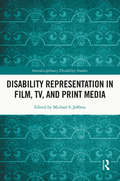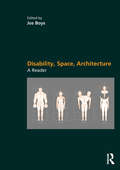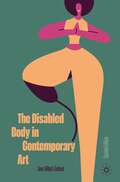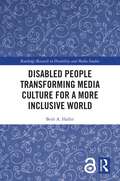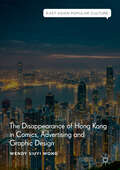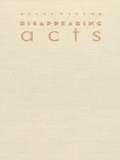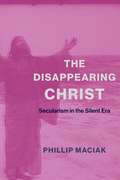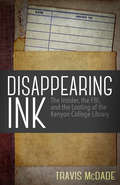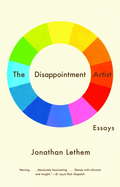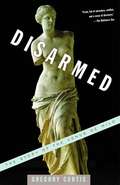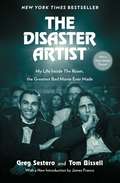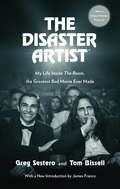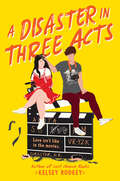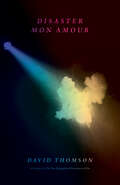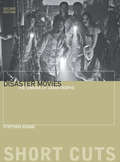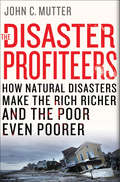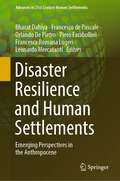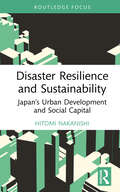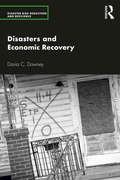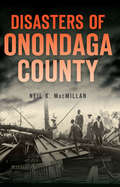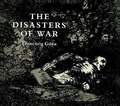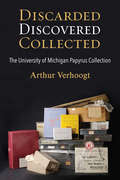- Table View
- List View
Disability Representation in Film, TV, and Print Media (Interdisciplinary Disability Studies)
by Michael S. JeffressUsing sources from a wide variety of print and digital media, this book discusses the need for ample and healthy portrayals of disability and neurodiversity in the media, as the primary way that most people learn about conditions. It contains 13 newly written chapters drawing on representations of disability in popular culture from film, television, and print media in both the Global North and the Global South, including the United States, Canada, India, and Kenya. Although disability is often framed using a limited range of stereotypical tropes such as victims, supercrips, or suffering patients, this book shows how disability and neurodiversity are making their way into more mainstream media productions and publications with movies, television shows, and books featuring prominent and even lead characters with disabilities or neurodiversity. Disability Representation in Film, TV, and Print Media will be of interest to all scholars and students of disability studies, cultural studies, film studies, gender studies, and sociology more broadly.
Disability, Space, Architecture: A Reader
by Jos BoysDisability, Space, Architecture: A Reader takes a groundbreaking approach to exploring the interconnections between disability, architecture and cities. The contributions come from architecture, geography, anthropology, health studies, English language and literature, rhetoric and composition, art history, disability studies and disability arts and cover personal, theoretical and innovative ideas and work. Richer approaches to disability – beyond regulation and design guidance – remain fragmented and difficult to find for architectural and built environment students, educators and professionals. By bringing together in one place some seminal texts and projects, as well as newly commissioned writings, readers can engage with disability in unexpected and exciting ways that can vibrantly inform their understandings of architecture and urban design. Most crucially, Disability, Space, Architecture: A Reader opens up not just disability but also ability – dis/ability – as a means of refusing the normalisation of only particular kinds of bodies in the design of built space. It reveals how our everyday social attitudes and practices about people, objects and spaces can be better understood through the lens of disability, and it suggests how thinking differently about dis/ability can enable innovative and new kinds of critical and creative architectural and urban design education and practice.
Disability Studies: Enabling the Humanities
by Sharon L. Snyder Brenda Jo Brueggemann Rosemarie Garland-ThomsonImages of disability pervade language and literature, yet disability is, as the volume's introduction notes, "the ubiquitous unspoken topic in contemporary culture." The twenty-five essays in Disability Studies provide perspectives on disabled people and on disability in the humanities, art, the media, medicine, psychology, the academy, and society.Edited and introduced by Sharon L. Snyder, Brenda Jo Brueggemann, and Rosemarie Garland-Thomson and containing an afterword by Michael Bérubé (author of Life As We Know It), the volume is rich in its cast of characters (including John Bulwer, Teresa de Cartagena, Audre Lorde, Oliver Sacks, Samuel Johnson, Mark Twain, Walt Whitman); in its powerful, authentic accounts of disabled conditions (deafness, blindness, MS, cancer, the absence of limbs); in its different settings (ancient Greece, medieval Spain, Nazi Germany, the modern United States); and in its mix of the intellectual and the emotional, of subtle theory and plainspoken autobiography.
The Disabled Body in Contemporary Art
by Ann Millett-GallantThis volume analyzes the representation of disabled and disfigured bodies in contemporary art and its various contexts, from art history to photography to medical displays to the nineteenth- and twentieth-century freak show.
The Disabled Body in Contemporary Art
by Ann Millett-GallantThe second edition offers an essential update to the foundational first edition, The Disabled Body in Contemporary Art. Featuring updated chapters and case studies, this second edition will not only expand on the first edition but will bring a new focus to contemporary disabled artists and their embodied, multimedia work.
Disabled People Transforming Media Culture for a More Inclusive World (Routledge Research in Disability and Media Studies)
by Beth A. HallerThis book tells the stories of disabled people who have been influential in creating modern mass media. Through the voices of key disabled media makers and collaborators, the author highlights the ways in which their contributions are changing society’s understanding of disability and shaping mass media and culture. Spanning a range of media formats – television/streaming productions, performances, podcasts, TED Talks, films, reality TV, graphic novels, and social media channels – the book illustrates how disabled people are confronting the marginalization they have faced in mass media for decades. Modern disabled media creators are leveraging new media platforms to recognize the lived experiences of disability and their authentic place in media culture. This innovative and thought-provoking volume will be an important read for scholars, disability advocates, and students of Disability Studies, Mass Communication/Media Studies, as well as mass media production faculty, disabled people, and their allies The Open Access version of this book, available at http://www.taylorfrancis.com, has been made available under a Creative Commons Attribution-Non Commercial-No Derivatives (CC-BY-NC-ND) 4.0 license.
The Disappearance of Hong Kong in Comics, Advertising and Graphic Design (East Asian Popular Culture)
by Wendy Siuyi WongThis book examines Hong Kong’s struggle against the disappearance of its unique identity under the historical challenges of colonialism, in addition to the more recent reimposition of Chinese authoritarian government control, as reflected in three under-researched forms of visual media: comics, advertising and graphic design. Each section of the book focuses on one of these three forms, and each chapter focuses on one stage of Hong Kong’s changing cultural identity. The articulative position of this book is on studies of visual cultural history and media communication. Its case studies will broaden readers’ own cultural knowledge for a more international understanding. The Disappearance of Hong Kong in Comics, Advertising and Graphic Design advances the development of its three key subjects in terms of identity, communication and cultural politics, aiming to reach a wide range of multidisciplinary readers.
Disappearing Acts: Spectacles of Gender and Nationalism in Argentina’s “Dirty War”
by Diana TaylorIn Disappearing Acts, Diana Taylor looks at how national identity is shaped, gendered, and contested through spectacle and spectatorship. The specific identity in question is that of Argentina, and Taylor's focus is directed toward the years 1976 to 1983 in which the Argentine armed forces were pitted against the Argentine people in that nation's "Dirty War." Combining feminism, cultural studies, and performance theory, Taylor analyzes the political spectacles that comprised the war--concentration camps, torture, "disappearances"--as well as the rise of theatrical productions, demonstrations, and other performative practices that attempted to resist and subvert the Argentine military.Taylor uses performance theory to explore how public spectacle both builds and dismantles a sense of national and gender identity. Here, nation is understood as a product of communal "imaginings" that are rehearsed, written, and staged--and spectacle is the desiring machine at work in those imaginings. Taylor argues that the founding scenario of Argentineness stages the struggle for national identity as a battle between men--fought on, over, and through the feminine body of the Motherland. She shows how the military's representations of itself as the model of national authenticity established the parameters of the conflict in the 70s and 80s, feminized the enemy, and positioned the public--limiting its ability to respond. Those who challenged the dictatorship, from the Mothers of the Plaza de Mayo to progressive theater practitioners, found themselves in what Taylor describes as "bad scripts." Describing the images, myths, performances, and explanatory narratives that have informed Argentina's national drama, Disappearing Acts offers a telling analysis of the aesthetics of violence and the disappearance of civil society during Argentina's spectacle of terror.
The Disappearing Christ: Secularism in the Silent Era
by Phil MaciakAt the turn of the twentieth century, American popular culture was booming with opportunities to see Jesus Christ. From the modernized eyewitness gospel of Ben-Hur to the widely circulated passion play films of Edison, Lumière, and Pathé; from D. W. Griffith’s conjuration of a spectral white savior in Birth of a Nation to W. E. B. Du Bois’s “Black Christ” story cycle, Jesus was constantly and inventively visualized across media, and especially in the new medium of film. Why, in an era traditionally defined by the triumph of secular ideologies and institutions, were so many artists rushing to film Christ’s miracles and use his story and image to contextualize their experiences of modernity?In The Disappearing Christ, Phillip Maciak examines filmic depictions of Jesus to argue that cinema developed as a model technology of secularism, training viewers for belief in a secular age. Negotiating between the magic trick and the documentary image, the conflicting impulses of faith and skepticism, the emerging aesthetic of film in this period visualized the fraught process of secularization. Cinematic depictions of an appearing and disappearing Christ became a powerful vehicle for Americans to navigate a rapidly modernizing society. Studying these films alongside a multimedia, interdisciplinary archive of novels, photographs, illustrations, and works of theology, travel writing, and historiography, The Disappearing Christ offers a new narrative of American cultural history at the intersection of cinema studies and religious studies.
Disappearing Ink: The Insider, the FBI, and the Looting of the Kenyon College Library
by Travis McDadeThe remarkable true story of the document heist that shocked the world. Like many aspiring writers, David Breithaupt had money problems. But what he also had was unsupervised access to one of the finest special collections libraries in the country. In October 1990, Kenyon College hired Breithaupt as its library’s part-time evening supervisor. In April 2000, he was fired after a Georgia librarian discovered him selling a letter by Flannery O’Connor on eBay, but that was only the tip of the iceberg: for the past ten years, Breithaupt had been browsing the collection, taking from it whatever rare books, manuscripts, and documents caught his eye—W. H. Auden annotated typescripts, a Thomas Pynchon manuscript, and much, much more. It was a large-scale, long-term pillaging of Kenyon College’s most precious works. After he was caught, the American justice system looked like it was about to disappoint the college the way it had countless rare book crime victims before—but Kenyon, refused to let this happen . . .
The Disappointment Artist: Essays
by Jonathan LethemA mixture of personal memory and cultural commentary, The Disappointment Artist offers a series of windows onto the collisions of art, landscape, and personal history that formed Jonathan Lethem's richly imaginative perspective on life at the end of the twentieth century. Lethem illuminates the process by which a child invents himself as a writer, and as a human being, through a series of approaches to the culture around him. In the title piece, a letter from his aunt (a children's book author) spurs a meditation on the value of writing workshops, the role and influence of reviews, and the uncomfortable fraternity of writers. In 'Defending The Searchers', Lethem explains how a passion for the classic John Wayne Western became occasion for a series of minor humiliations. In 'Identifying with Your Parents', an excavation of childhood love for superhero comics expands to cover a whole range of nostalgia for a previous generation's cultural artefacts. And '13/1977/21', which begins by recounting the summer he saw Star Wars twenty-one times, 'slipping past ushers who'd begun to recognize me. . . ', becomes a meditation on the sorrow and solace of the solitary moviegoer.
Disarmed: The Story of the Venus de Milo
by Greg CurtisIn the spring of 1820, on the Aegean island of Melos, an unsuspecting farmer was digging for marble building blocks when he unearthed the statue that would come to be known as the Venus de Milo. From the moment of its discovery a battle for possession ensued and was won, eventually, by the French. Touted by her keepers in the Louvre as the great classical find of the era, the sculpture gained instant celebrity–and yet its origins had yet to be documented or verified. From the flurry of excitement surrounding her discovery, to the raging disputes over her authenticity, to the politics and personalities that have given rise to her mystique, Gregory Curtis has given us a riveting look at the embattled legacy of a beloved icon and a remarkable tribute to one of the world’s great works of art.
The Disaster Artist
by Tom Bissell Greg SesteroFrom the actor who lived through it all and an award-winning narrative nonfiction writer: the inspiring and laugh-out-loud funny story of a mysteriously wealthy social misfit who got past every road block in the Hollywood system to achieve success on his own terms--the making of The Room, "the Citizen Kane of bad movies" (Entertainment Weekly).In 2003, an independent film called The Room--written, produced, directed, and starring a very rich social misfit of indeterminate age and origin named Tommy Wiseau--made its disastrous debut in Los Angeles. Described by one reviewer as "like getting stabbed in the head," the $6 million film earned a grand total of $1,800 at the box office and closed after two weeks. Now in its tenth anniversary year, The Room is an international phenomenon to rival The Rocky Horror Picture Show. Thousands of fans wait in line for hours to attend screenings complete with costumes, audience rituals, merchandising, and thousands of plastic spoons. Readers need not have seen The Room to appreciate its costar Greg Sestero's account of how Tommy Wiseau defied every law of artistry, business, and interpersonal relationships to achieve the dream only he could love. While it does unravel mysteries for fans--who on earth is "Steven," and what's with that hospital on Guerrero Street?--The Disaster Artist is more than just a hilarious story about cinematic hubris. It is ultimately a surprisingly inspiring tour de force that reads like a page-turning novel, an open-hearted portrait of an enigmatic man who will capture your heart.
The Disaster Artist: My Life Inside The Room, the Greatest Bad Movie Ever Made
by Greg Sestero Tom BissellNow a major motion picture, The Disaster Artist, starring James Franco, Alison Brie, Zoey Deutch, Lizzy Caplan, Zac Efron, Bryan Cranston, Dave Franco, Kristen Bell, Seth Rogen, Sharon Stone, and Judd Apatow.In 2003, an independent film called The Room - starring and written, produced, and directed by a mysteriously wealthy social misfit named Tommy Wiseau - made its disastrous debut in Los Angeles. Described by one reviewer as 'like getting stabbed in the head', the $6 million film earned a grand total of $1,800 at the box office and closed after two weeks. Over a decade later, The Room is an international cult phenomenon, whose legions of fans attend screenings featuring costumes, audience rituals, merchandising and thousands of plastic spoons. In The Disaster Artist, Greg Sestero, Tommy's costar, recounts the film's bizarre journey to infamy, explaining how the movie's many nonsensical scenes and bits of dialogue came to be and unraveling the mystery of Tommy Wiseau himself. But more than just a riotously funny story about cinematic hubris, The Disaster Artist is an honest and warm testament to friendship.
A Disaster in Three Acts
by Kelsey RodkeyFans of Elise Bryant and Rachel Lynn Solomon will swoon for Last Chance Books author Kelsey Rodkey’s next romance, packed with snark, banter, and inconvenient crushes.Saine Sinclair knows a little something about what makes a story worth telling.Your childhood best friend refuses to kiss you during a pre-adolescent game of spin the bottle? Terrible, zero stars, would not replay that scene again. The same ex-friend becomes your new best friend’s ex? Strangely compelling, unexpected twist, worth a hate-watch. That same guy—why is he always around?—turns out to be your last shot at getting into the documentary filmmaking program of your dreams? Saine hates to admit it, but she’d watch that movie.There’s something about Holden that makes her feel like she’s the one in front of the camera—like he can see every uncomfortable truth she’s buried below the surface. Saine knows how her story’s supposed to go. So why does every moment with Holden seem intent on changing the ending?
Disaster Mon Amour
by David ThomsonA deep—and darkly comic—dive into the nature of disasters, and the ways they shape how we think about ourselves in the world &“In this brilliant book, David Thomson tells the story of how we came to make disaster and catastrophe our best friends—how we let terror cocoon and take over our imaginations to avoid seeing the things that really frighten us. Riveting and totally original.&”—Adam Curtis, BBC filmmaker and political journalist &“Erudite. . . . Engaging. . . . A cri de coeur about art&’s struggle to keep up with reality.&”—Kirkus Reviews Audiences swell with the scale of disaster; humans have always been drawn to the rumors of our own demise. In this searching treatment, noted film historian David Thomson examines iconic disasters, both real and fictional, exposing the slippage between what occurs and what we observe. With reportage, film commentary, speculation, and a liberating sense of humor, Thomson shows how digital culture commodifies disaster and sates our desire to witness chaos while suffering none of its aftereffects. Ranging from Laurel and Hardy and Battleship Potemkin to Cormac McCarthy&’s The Road, and from the epic San Andreas to the intimate Don&’t Look Now, Thomson pulls back the curtain to reveal why we love watching disaster unfold—but only if it happens to others.
Disaster Movies: The Cinema of Catastrophe (Short Cuts)
by Stephen KeaneStephen Keane's history of the disaster genre offers a detailed analysis of films such as The Towering Inferno, Independence Day, Titanic, and The Day After Tomorrow. He looks at the ways in which disaster movies can be read in relation to both contextual considerations and the increasing commercial demands of contemporary Hollywood. In this second edition, he adds new material regarding cinematic representations of disaster in the wake of 9/11 and an analysis of disaster movies in light of recent natural disasters. Keane continually reworks this previously unexplored genre.
Disaster Movies
by Stephen KeaneStephen Keane's history of the disaster genre offers a detailed analysis of films such as The Towering Inferno, Independence Day, Titanic, and The Day After Tomorrow. He looks at the ways in which disaster movies can be read in relation to both contextual considerations and the increasing commercial demands of contemporary Hollywood. In this second edition, he adds new material regarding cinematic representations of disaster in the wake of 9/11 and an analysis of disaster movies in light of recent natural disasters. Keane continually reworks this previously unexplored genre.
The Disaster Profiteers
by John C. MutterNatural disasters don't matter for the reasons we think they do. They generally don't kill a huge number of people. Most years more people kill themselves than are killed by Nature's tantrums. And using standard measures like Gross Domestic Product (GDP) it is difficult to show that disasters significantly interrupt the economy.It's what happens after the disasters that really matters-when the media has lost interest and the last volunteer has handed out a final blanket, and people are left to repair their lives. What happens is a stark expression of how unjustly unequal our world has become. The elite make out well-whether they belong to an open market capitalist democracy or a closed authoritarian socialist state. In Myanmar-a country ruled by a xenophobic military junta-the generals and their cronies declared areas where rice farms were destroyed by Cyclone Nargis as blighted and simply took the land. In New Orleans the city was re-shaped and gentrified post Katrina, making it almost impossible for many of its poorest, mostly black citizens to return.In The Disaster Profiteers, John Mutter argues that when no one is looking, disasters become a means by which the elite prosper at the expense of the poor. As the specter of increasingly frequent and destructive natural disasters looms in our future, this book will ignite an essential conversation about what we can do now to create a safer, more just world for us all.
Disaster Resilience and Human Settlements: Emerging Perspectives in the Anthropocene (Advances in 21st Century Human Settlements)
by Bharat Dahiya Francesco De Pascale Orlando De Pietro Piero Farabollini Francesca Romana Lugeri Leonardo MercatantiThis book presents emerging perspectives on disaster resilience and human settlements in the larger context of the Anthropocene. The chapters explore urban and rural perspectives focusing on the current and emerging perspectives on disaster resilience through a holistic approach, involving scientists, humanists, planners, policymakers, and professionals in the global debate.
Disaster Resilience and Sustainability: Japan’s Urban Development and Social Capital (Routledge Research in Sustainable Planning and Development in Asia)
by Hitomi NakanishiThis book examines urban planning and infrastructure development in Japanese cities after the second world war as a way to mitigate the risks of disasters while pursuing sustainable development. It looks at the benefits of social capital and how communities organise to tackle problems during the recovery phase after a disaster. The book also illustrates with case studies to highlight community attitudes which improve recovery outcomes. The book underlines challenges such as ageing and depopulation which Japan would face should the next disaster occur. These demographic shifts are causing difficulties among neighbourhood associations at a time when communities need to effectively support each other. Nakanishi explains why overcoming these societal issues is imperative for sustainability and the need for a comprehensive approach which would integrate smart technology. This book will be of interest to scholars in city development and planning, urban studies and human geography, as well as those interested in building resilient communities.
Disasters and Economic Recovery (Disaster Risk Reduction and Resilience)
by Davia C. DowneyDisasters and Economic Recovery provides perspectives on the economic issues that emerge before, during, and after natural disasters in an international context, by assessing the economic development patterns that emerge before and after disaster. This book will provide a historical overview of emergency management policy and previous responses to disasters in each country, as well as the policy learning that occurred in each case leading up to the disasters under analysis. The book highlights four cases: New Orleans; Christchurch, New Zealand; the Japan earthquake and tsunami; and Hurricane Sandy in the Northeastern United States. The book places important focus on the specific collaborative developments unique to the rebuilding of each place’s economy post-disaster. Using time-series data, the book shows the emergence of new industries and job hiring patterns in the immediate aftermath, as well as provides a picture of the economic performance of each country in the years following each event. Looking at the economic development policies pre- and post-disaster, readers will glean important lessons on how to build resilient economies within the disaster framework, highlighting the differences in approaches to rebuilding local economies in places with varying levels of governmental capacity post-disaster to inform policymakers, scholars, and the disaster relief community as they plan their response to future disasters.
Disasters of Onondaga County (Disaster)
by Neil K. MacmillanThe city of Syracuse and Onondaga County have a long and storied history of natural and man-made calamity. Although often considered a moderate weather region, Mother Nature has not spared it from destruction. A tornado devastated picturesque Longbranch Park in 1912, and the rare Hurricane Hazel reached Onondaga’s borders in 1954. A fire ravaged Syracuse’s famed Bastable Block building in 1923. During a children’s concert and festival, the floor of the Central Baptist Church collapsed, tragically claiming scores of lives and injuring more than one hundred. Author and historian Neil MacMillan charts the history of Onondaga County catastrophes.
The Disasters of War
by Francisco GoyaThe strikingly original characterizations and sharply drawn scenes that came to be known posthumously as Los Desastres de la Guerra (The Disasters of War) are among Francisco Goya's most powerful works and one of the masterpieces of Western civilization. Goya's model for his visual indictment of war and its horrors was the Spanish insurrection of 1808 and the resulting Peninsular War with Napoleonic France. The bloody conflict and the horrible famine of Madrid were witnessed by Goya himself, or were revealed to him from the accounts of friends and contemporaries. From 1810 to 1820, he worked to immortalize them in a series of etchings.The artist himself never saw the results. The etchings were not published until 1863, some 35 years after his death. By then, the passions of the Napoleonic era had subsided and the satirical implications in Goya's work were less likely to offend. The Dover edition reproduces in its original size the second state of this first edition, which contained 80 prints. Three additional prints not in the 1863 edition are also included here, making this the most complete collection possible of the etchings Goya intended for this series. The bitter, biting captions are reprinted, along with the new English translations, as are the original title page and preface.
Discarded, Discovered, Collected: The University of Michigan Papyrus Collection
by Arthur VerhoogtDiscarded, Discovered, Collected provides an accessible introduction to the University of Michigan’s collection of papyri and related ancient materials, the widest and deepest resource of its kind in the Western hemisphere. The collection was founded in the early part of the 20th century by University of Michigan Professor of Classics Francis W. Kelsey. His original intention was to create a set of artifacts that would be useful in teaching students more directly about the ancient world, at a time when trips to ancient sites were much harder to arrange. Jointly administered by Michigan’s Department of Classical Studies and its Library, the collection has garnered significant interest beyond scholarly circles and now sees several hundred visitors each year. Of particular note among its holdings are sixty pages of the earliest known copy of the Epistles of St. Paul, which are often featured on tours of the collection by groups from religious institutions. Arthur Verhoogt, one of the current stewards of the Papyrology Collection, provides clear, insightful information in an appealing style to engage general readers and scholars alike. Extensively illustrated with some of the collection’s more spectacular pieces, this volume describes what the collection is, what kinds of ancient texts it contains, and how it has developed from Francis Kelsey’s day to the present. Verhoogt describes in detail how people who study papyri carry out their work, and how papyri contribute to our understanding of various aspects of the ancient Greco-Roman world. Translations of the ancient texts are presented so that the reader can experience some of the excitement that comes with reading original documents from many centuries ago.
